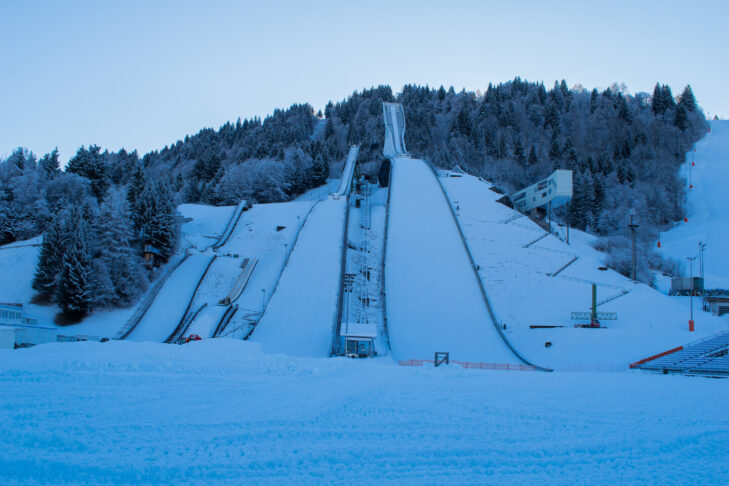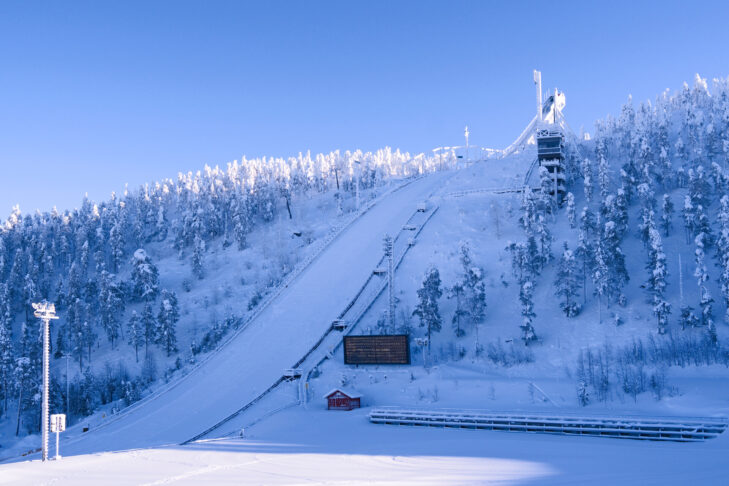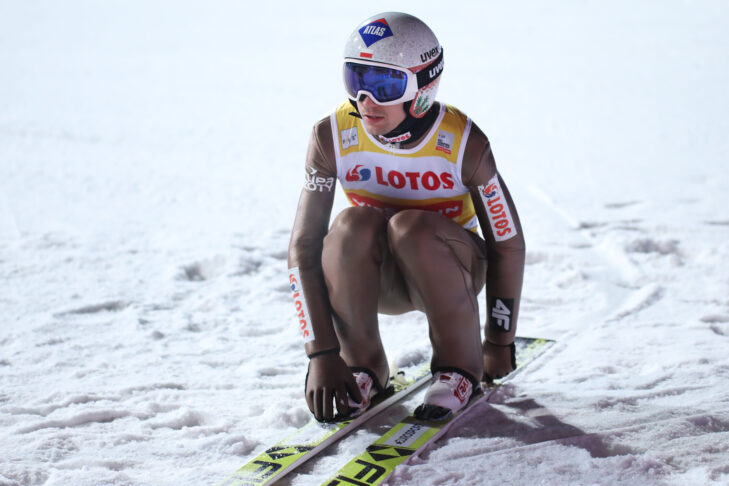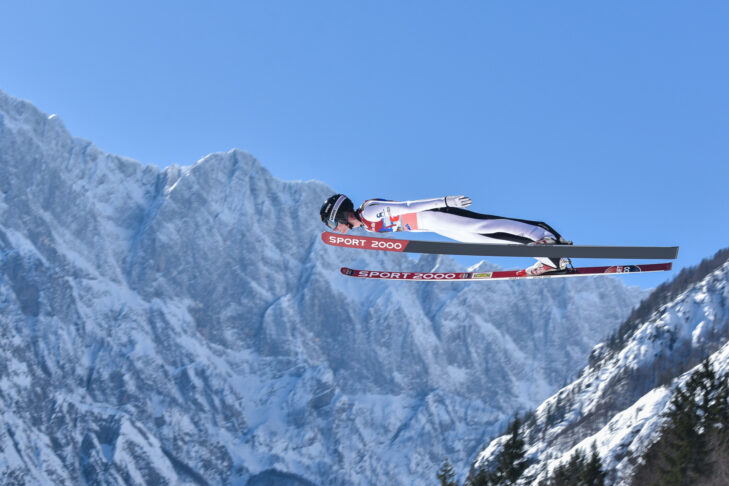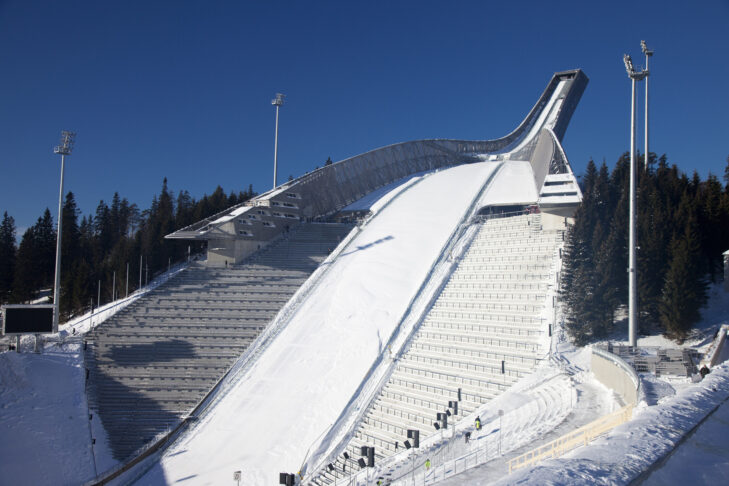Ski jumping is fascinating. The FIS Ski Jumping World Cup is the Champions League of their sport for the daring athletes who venture onto the world’s largest ski jumps year after year. With spectacular jumps and hill records, stars such as last season’s overall World Cup winners Daniel Tschofenig (Austria) and Nika Prevc (Slovenia) ensure top ratings and sold-out ski jumping stadiums from late autumn to spring. On its way around the globe, the ski jumping circus stops off at several new World Cup arenas and many traditional venues that have been cathedrals of Nordic skiing for decades. SnowTrex has compiled all the venues for the 2025/2026 World Cup and shows the most important ski jumping events of the year.
This is the Ski Jumping World Cup
- Start of the 2025/2026 Ski Jumping World Cup season: The World Cup starts from 20 to 23 November 2025 in Lillehammer, Norway, the venue of the 1994 Winter Olympics.
- First competition on the normal hill in 2025/2026: At the second World Cup stop in Falun (Sweden), women and men will also be jumping from the normal hill between 24 and 30 November 2025.
- Ski flying 2026 dates: The 2026 Ski Flying World Championships will take place from 22 to 25 January in Oberstdorf, while two more ski flying events for men and women are scheduled for March 2026 in Vikersund (Norway) and Planica (Slovenia).
- Ski Jumping World Cup 2026 final: The 2025/2026 competition season ends from 26 to 29 March 2026 with ski flying in Planica (Slovenia).
- Traditional World Cup opening ceremony in ski jumping: Between 2016 and 2022, the opening event usually took place in Wisła, since 2024 Lillehammer (Norway) is now the host.
- History of the Ski Jumping World Cup: The first competition took place in Cortina d’Ampezzo in 1979, while the Women’s World Cup began in 2011/2012.
- TV coverage and prize money in the Ski Jumping World Cup: The competitions are broadcast live on ARD, ZDF and Eurosport. The men receive 12,109 pounds and the women 4,005 pounds per World Cup win.
Competitions of the 2025/2026 Women’s Ski Jumping World Cup at a glance
| Date | Ski Resort | Country | Disciplines |
|---|---|---|---|
| 30.12. - 31.12.25 (Two Nights Tour) | Garmisch-Partenkirchen | Germany | Large Hill |
| 29.01. - 31.01.26 | Zao | Japan | Normal Hill |
| 29.01. - 01.02.26 | Willingen | Germany | Large Hill & Mixed Team Large Hill |
| 27.11. - 30.11.25 | Falun | Sweden | Large Hill & Normal Hill |
| 26.03. - 29.03.26 | Planica | Slovenia | Ski Flying |
| 26.02. - 28.02.26 | Hinzenbach | Austria | Normal Hill |
| 23.01. - 25.01.26 | Sapporo | Japan | Large Hill |
| 20.11. - 23.11.25 | Lillehammer | Norway | Large Hill & Mixed Team Large Hill |
| 20.03. - 22.03.26 (RAW Air) | Vikersund | Norway | Ski Flying |
| 19.12. - 21.12.25 | Engelberg | Switzerland | Large Hill |
| 13.03. - 15.03.26 (RAW Air) | Oslo | Norway | Large Hill |
| 12.12. - 14.12.25 | Lake Placid | USA | Large Hill & Mixed Team Large Hill |
| 09.01. - 11.01.26 | Ljubno | Slovenia | Normal Hill |
| 07.02. - 16.02.26 (Winter Olympics) | Predazzo | Italy | Large Hill, Mixed Team Normal Hill & Normal Hill |
| 05.03. - 08.03.26 | Lahti | Finland | Large Hill |
| 05.01. - 06.01.26 | Villach | Austria | Normal Hill |
| 03.12. - 07.12.25 | Wisla | Poland | Large Hill |
| 01.01.26 (Two Nights Tour) | Oberstdorf | Germany | Large Hill |
Competitions of the 2025/2026 Men’s Ski Jumping World Cup at a glance
| Date | Ski Resort | Country | Disciplines |
|---|---|---|---|
| 20.11. - 23.11.25 | Lillehammer | Norway | Large Hill & Mixed Team Large Hill |
| 24.11. - 26.11.25 | Falun | Sweden | Large Hill & Normal Hill |
| 28.11. - 30.11.25 | Ruka | Finland | Large Hill |
| 03.12. - 07.12.25 | Wisla | Poland | Large Hill |
| 12.12. - 14.12.25 | Lake Placid | USA | Large Hill & Mixed Team Large Hill |
| 19.12. - 21.12.25 | Engelberg | Switzerland | Large Hill |
| 28.12. - 29.12.25 (Four Hills Tournament) | Oberstdorf | Germany | Large Hill |
| 31.12.25 - 01.01.26 (Four Hills Tournament) | Garmisch-Partenkirchen | Germany | Large Hill |
| 03.01. - 04.01.26 (Four Hills Tournament) | Innsbruck | Austria | Large Hill |
| 05.01. - 06.01.26 (Four Hills Tournament) | Bischofshofen | Austria | Large Hill |
| 09.01. - 11.01.26 | Zakopane | Poland | Large Hill & Team Large Hill |
| 16.01. - 18.01.26 | Sapporo | Japan | Large Hill |
| 22.01. - 25.01.26 (Ski Flying World Championships) | Oberstdorf | Germany | Ski Flying & Team Ski Flying |
| 29.01. - 01.02.26 | Willingen | Germany | Large Hill & Mixed Team Large Hill |
| 07.02. - 16.02.26 (Winter Olympics) | Predazzo | Italy | Large Hill, Mixed Team Normal Hill, Normal Hill & Super Team Large Hill |
| 27.02. - 01.03.26 | Kulm | Austria | Ski Flying |
| 05.03. - 08.03.26 | Lahti | Finland | Large Hill & Super Team Large Hill |
| 13.03. - 15.03.26 (RAW Air) | Oslo | Norway | Large Hill |
| 20.03. - 22.03.26 (RAW Air) | Vikersund | Norway | Ski Flying |
| 26.03. - 29.03.26 | Planica | Slovenia | Ski Flying & Team Ski Flying |
The highlights of the 2025/2026 World Cup season
20. until 23 November: Ruka (Finland)
The third stop of the 2025/2026 Ski Jumping World Cup takes place just 50 kilometres south of the Arctic Circle, after the opening event in Lillehammer (Norway) and a week after the second competition stop in Falun (Sweden). In addition to competitions in cross-country skiing and Nordic combined, the Finnish ski sports centre Ruka will also host two World Cup ski jumping competitions. Two competitions will be held under floodlights on the Rukatunturi ski jump over the weekend. With a hill size, which describes the distance between the take-off and the end of the landing area, of 142 metres, the facility was the world’s largest ski jumping hill until 2003.
19. until 21 December: Engelberg (Switzerland)
In Switzerland, the ski jumping circus will only make one stop in the new winter sports season, namely in Engelberg. The monastery town in the canton of Obwalden will host two individual competitions each for men and women on the Gross Titlis ski jump. As the World Cup will not be returning to the Swiss Confederation this year, tens of thousands of spectators will be in Engelberg. Three days before Christmas Eve, the event will take place on the large hill, which has a hill size of 140 metres and was last converted in 2016.
→ Discover Engelberg offers at SnowTrex now
28. and 29 December: Oberstdorf (Germany)
The world-famous Four Hills Tournament traditionally begins in the Allgäu four days before the turn of the year, with 87,058 pounds Swiss francs in prize money for the overall winner at the end. Oberstdorf has always been the venue for the opening competition in Germany since 1953. The qualification of the best 50 jumpers takes place the day before, before the first round on 29 December is held in knockout mode, as is usual in the tour. Incidentally, not only the spectators in the stands, but also skiers and snowboarders will have a perfect view of the jumping action on the Schattenbergschanze, which was one of the competition venues for the 2021 Nordic World Ski Championships. High above the landing hill, the Nebelhornbahn gondolas take you directly to Oberstdorf’s local ski area.
31. December and 01 January: Garmisch-Partenkirchen (Germany)
The most prestigious individual event and one of the most important dates in the Ski Jumping World Cup is undoubtedly the New Year’s Day event in Garmisch-Partenkirchen. This makes the town in the shadow of the Zugspitze the only one in Germany to host both the Ski Jumping and Alpine Skiing World Cup in 2024. The competition stage for the world’s elite ski jumpers has been the “Great Olympic Hill” since the first Four Hills Tournament in 1952. However, the very first competition on the Gudiberg took place back in 1922. This makes the facility, which was last extended to a hill size of 142 metres in 2007, the oldest of the four touring hills. Sven Hannawald was the last athlete from Germany to win the New Year’s competition over 20 years ago.
→ Discover Garmisch-Partenkirchen offers at SnowTrex now
03. and 04 January: Innsbruck (Austria)
The Bergisel ski jump is also a tradition. With a hill size of 128 m, the ski jump on the local mountain of the Tyrolean capital is the smallest of the four tour facilities, but offers a spectacular view of Innsbruck‘s city centre thanks to its location on the slope. Technically, the 1964 Olympic ski jump is considered particularly challenging by World Cup ski jumpers. The weather conditions in particular often make the competitions on the Bergisel in Austria a real challenge for the athletes. in 2022, for example, the planned competition had to be completely cancelled due to strong winds and held a day later in Bischofshofen.
→ Discover Innsbruck offers at SnowTrex now
05. and 06 January: Bischofshofen (Austria)
Who is the king of the air? This question is answered year after year in Bischofshofen. The fourth and final tour competition on the Paul-Außerleitner-Schanze often turns into a sporting thriller due to the exciting duels for overall victory. The facility is a natural ski jump with a hill size of 142 metres. With a capacity of 25,000 spectators, the ski stadium, which is named after the first tour winner Sepp Bradl, is one of the largest sports venues in Austria. The extraordinary atmosphere at the Dreikönigsspringen makes the final event extremely popular with athletes and spectators alike.
→ Plan your time out in the Alps and find Bischofshofen offers at SnowTrex
09. until 11 January: Zakopane (Poland)
There are few World Cup venues where ski jumpers are celebrated as frenetically as in Zakopane. Visitors to the Wielka Krokiew natural ski jump can barely understand their own words, especially when the local athletes jump. In addition to an individual competition, the second World Cup stop in Poland, after the mixed event in Lake Placid (USA) in December 2025, will also feature the first traditional team competition of the 2025/2026 winter season. Alongside the jumpers from the host country, the favourites are the teams from Germany, Norway, Austria and Slovenia.
→ Discover Zakopane offers at SnowTrex now
16. until 18 January & 23 to 25 January: Sapporo (Japan)
The longest journey of the year takes the ski jumpers to Japan in mid-January before travelling to Asia at the end of January. In Sapporo, where the 1972 Winter Olympics were held, the women will compete in two individual competitions on the Ōkurayama hill (137 m hill size) and the men will also jump twice on the large hill.
22. and 25 January: Oberstdorf (Germany)
Oberstdorf, the second. After the opening competition of the Four Hills Tournament in December 2025, the world’s best ski jumpers will return to the Allgäu at the start of 2026. However, instead of jumping from the Schattenberg ski jump in the heart of the village, this time the athletes will “sail” down to the valley at the Ski Flying World Championships. And from the largest facility of its kind in Germany: the Heini-Klopfer-Skiflugschanze (235 m hill size), one of the highlights of the 2025/2026 Ski Jumping World Cup, where Domen Prevc from Slovenia holds the current hill record with 242.5 m. It may well be that this distance is shaky at the World Championships, as four competition rounds and a team competition are on the programme as part of the event.
→ Secure unforgettable skiing moments in Oberstdorf with SnowTrex now
29. January to 01 February: Willingen (Germany)
Ski jumping party in the Hochsauerland! In friendly competition with Zakopane, the event in Willingen vies for the title of the loudest World Cup venue every year. At the Mühlenkopfschanze, distances are cheered that ski jumpers usually only surpass on ski flying facilities. With a hill size of 147 metres, the facility in Hochsauerland is currently the largest ski jumping hill in the world. In the 2025/2026 season, the last joint Ski Jumping World Cup will be held here before the start of the 2026 Winter Olympics in Milan and Cortina d’Ampezzo.
What does a jump from the world’s largest ski jump in Willingen look like? This question is answered by the spectacular helmet camera footage in the following video:
→ Discover Willingen offers at SnowTrex now
27. February to 08 March: Predazzo (Italy)
The annual highlight for ski jumpers in 2026 will not take place in Milan or Cortina, but in Predazzo, Italy. The ski jumping competitions of the 25th Winter Olympics will be held here in the Fiemme Valley from 7 to 16 February! There are three competitions for the women and four for the men in Italy during this period. Both have an individual competition on the normal hill (109 m hill size) and on the large hill (143 m hill size) as well as a mixed team competition with two women and two men per nation, again on the normal hill. On 16 February, the men’s super team event will also take place on the large hill facility.
→ Discover Predazzo offers at SnowTrex now
13. and 15 March: Oslo (Norway)
For Nordic skiers, the Holmenkollen in Oslo is a kind of sanctuary. No other competition, at any of the aforementioned venues in the Ski Jumping World Cup, is associated with as much myth as the event in Norway’s capital. The ski jumpers, for whom an individual competition on the large hill (134 m hill size) is on the agenda as part of the “RAW Air” tour in the 2025/2026 season, are correspondingly in awe and anticipation. The reward for winning in Oslo is a very special one. In addition to the prize money, the first-placed athletes will be able to meet the Norwegian king, Harald V, who is himself a big sports fan, in the royal box after the award ceremony.
20. and 22 March: Vikersund (Norway)
236 m. This is how far the Slovenian Nika Prevc flew on 14 March 2025 in Vikersund, and because she did not reach into the snow when landing, this distance was recorded as a new ski flying world record. A mark that will still stand in 2026, making Vikersundbakken the largest ski jumping hill in the world for female ski jumpers (240 m hill size). On the facility, which is also reverently referred to by the locals as the “Monsterbakken”, the ski jumpers each complete two individual jumps. The points from these competitions are then included in the ranking of the “RAW Air” tour, which was held for the first time in 2017. And the overall winners will receive a handsome prize of 34,823 pounds for men and women.
26. until 29 March: Planica (Slovenia)
At the end of the 2025/2026 season, the athletes will once again be travelling to Planica. And, as in Oberstdorf and Vikersund, for the third time in the current World Cup season it’s not about ski jumping, as ski flying is also a tradition in the Julian Alps. On the “Letalnica bratov Gorišek”, the ski flying hill of the Gorišek brothers, Domen Prevc, like his sister Nika on the Norwegian “Monsterbakken”, currently holds not only the hill record but also the ski flying world record with 254.5 metres! Incidentally, the battle for the overall World Cup will also be decided in Planica at the latest as part of two individual competitions, which will also finalise the results in the 2025/2026 Ski Jumping World Cup.
FAQs on the Ski Jumping World Cup
When does the Ski Jumping World Cup 2025/2026 start?
The 2025/2026 Ski Jumping World Cup season opener will take place in Lillehammer, Norway, on the weekend of 20 to 23 November. The world’s best ski jumpers will meet at the start of the new competition series in the venue of the 1994 Winter Olympics.
When will the first competition on a normal hill take place in the 2025/2026 season?
The first ski jumping competition on a normal hill in the 2025/2026 season will take place from 24 to 30 November in Falun, Sweden, where the gold medals were won at the Nordic World Ski Championships in 2015.
When will the first ski flying event of the 2025/2026 season take place?
The first ski flying event of the 2025/2026 season will take place on the Heini-Klopfer-Skiflugschanze in Oberstdorf (Germany). The men will compete there in the Allgäu region from 22 to 25 January in an individual competition (with four competition jumps) and a team flying event as part of the 2026 Ski Flying World Championships. The women also have two ski flying events in this World Cup season, one from 20 to 22 March on the “Monsterbakken”, the world’s largest ski flying hill, in Vikersund, Norway, and one from 26 to 29 March in Planica, Slovenia.
Where does the 2025/2026 Ski Jumping World Cup end?
To bring the FIS Ski Jumping World Cup to a fitting end, the ski jumpers will meet once again from 26 to 29 March in Planica, Slovenia, for ski flying.
Where does the Ski World Cup season opener traditionally take place?
Between 2016 and 2022, the first competition of the FIS Ski Jumping World Cup was held in Wisla, Poland, for six years. in 2023, the season opener then returned to the traditional Nordic Opening in Ruka (Finland). After 2024, the event will also be held in Lillehammer (Norway), the 1994 Olympic city, in 2025.
How long has the Ski Jumping World Cup existed?
The first official season of the Ski Jumping World Cup kicked off in 1979, with the very first competition taking place on 27 December in Cortina d’Ampezzo, which was won by Austrian Toni Innauer. The women, on the other hand, were only allowed to compete in their very first official World Cup competition in the 2011/2012 season. On 3 December, Sarah Hendrickson from the USA won the individual competition on the normal hill in Lillehammer.
Where can viewers watch the Ski Jumping World Cup on TV?
The live broadcasts of the Ski Jumping World Cup are primarily shown across the UK on Eurosport, which is part of the Warner Bros. Discovery (WBD) sports portfolio. Viewers can watch the full coverage of all competitions either on the dedicated Eurosport channels (often included in packages like TNT Sports) or via the streaming service discovery+. The broadcaster typically provides comprehensive coverage of all World Cup events throughout the season.
How much money do the winners of the Ski Jumping World Cup earn?
Neither the winner nor the female winner receives any prize money for 1st place in the Ski Jumping World Cup. Instead, a victory in a men’s World Cup competition is endowed with 13,000 Swiss francs, the equivalent of 12,109 pounds (as of 30 June 2025). In the women’s competition, the winner of a jumping event receives 4,300 Swiss francs, equivalent to 4,005 pounds (as at 30 June 2025). It is also a tradition in winter sports that the overall World Cup trophies are made of the finest crystal glass. This is why the best female and male ski jumper are honoured by the FIS with two large “crystal balls”. However, the ski jumpers do not derive most of their income from the prize money, but from sponsorship contracts, some of which are extremely well endowed.

